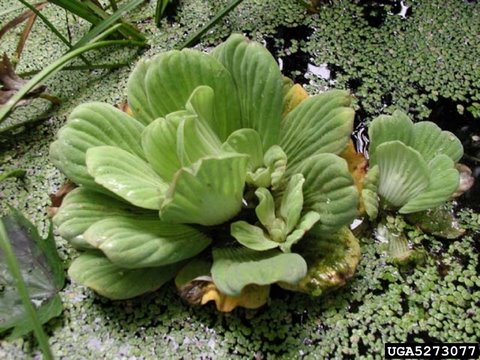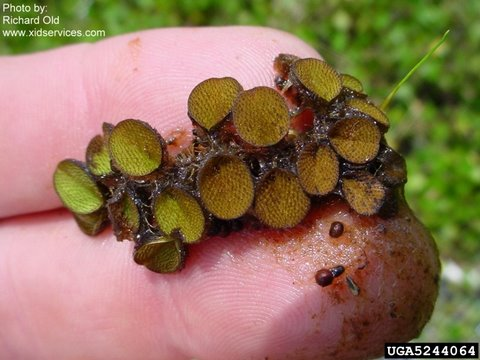Pretty but problematic: Aquatic plants to avoid
Often used in aquariums or garden ponds, these 3 plants can be a problem in the Great Lakes.

Aquariums and water gardens are a fun way to appreciate aquatic plants in your home or backyard. Many people enjoy keeping a variety of colorful, resilient aquatic plants in fish tanks or outdoor ponds – but some of the most popular species are at risk of becoming invasive if introduced to the Great Lakes. This article highlights three common floating water garden and aquarium plants – water hyacinth (Eichhornia crassipes), water lettuce (Pistia stratiotes), and water spangles (Salvinia minima) – featured on the Watchlist of the Great Lakes Aquatic Nonindigenous Species Information System (GLANSIS).
Common traits make these plants a risk
Water hyacinth, water lettuce, and water spangles all look different but they share common traits that make them a risk to Great Lakes ecosystems. All are free-floating plants, which allows them to easily spread downstream or during flooding conditions. They all reproduce by cloning themselves, and all were originally introduced to be used in aquariums or water gardens. All three species are relatively new invaders in the Great Lakes, and remain on the GLANSIS Watchlist.
These three plants are known for creating dense, floating mats at the surface of the water, blocking sunlight to the water column below. This lack of light decreases the amount of native plankton and algae in the water column and disrupts the food chain. The decaying leaf matter produced by these plants can cause a decrease in oxygen as bacteria and other decomposers consume it. Masses of floating vegetation produced by these plants can also restrict water access for boaters and swimmers, provide a breeding ground for mosquitoes, and even clog water intakes for power plants and irrigation projects. Learning to identify these invasive plants is an important way to help stop their spread.
Water hyacinth
Water hyacinth (Eichhornia crassipes) is a free-floating plant named for its showy clusters of light purple flowers, which resemble those of a garden hyacinth plant. It has thick, waxy leaves that end in round air bladders that help the plant float. Native to the Amazon Basin in South America, this plant is popular in ornamental ponds for its attractive appearance and its ability to absorb excess nutrients from the water. Water hyacinth can grow quickly – populations can double in two weeks under ideal conditions.
This species has been reported in multiple locations around the Midwest, including in Michigan’s Livingston, Macomb, and Wayne counties. Water hyacinth is especially persistent in the lower Detroit River and western Lake Erie, where it remains unclear whether populations are dying off during mild winters or managing to survive. Learn more about this species through its GLANSIS profile online.
Water lettuce

Water lettuce (Pistia stratiotes) is named for its resemblance to a floating head of lettuce, with soft, dense hairs covering its distinctly-veined leaves and feathery clumps of submerged roots. This species is a very popular aquarium and water garden plant due to its attractive leaf rosettes, its ability to shade out algae growth, and the fact that its submerged roots provide shelter for young ornamental fish and shrimp.
Scattered populations of water lettuce have been found between spring and fall in Lake St. Clair, the Detroit River, and other inland waters in Michigan, Ohio, New York, Minnesota, and Ontario. Although the plant dies back during hard frosts and so far does not appear to be able to survive winter in the Great Lakes region, repeated sightings throughout the basin suggest that the plant is being regularly reintroduced by people, whether accidentally or deliberately. You can learn more about this species through its GLANSIS profile online.
Water spangles

Water spangles (Salvinia minima) may look like a cluster of miniature lily pads, but are actually a type of aquatic fern. These small plants do not have true roots, but have submerged leaves that branch into filament-like structures along with pairs of oval leaves covered with water-repellant hairs that allow them to float. This species is believed to be sterile, but reproduces by cloning itself by splitting into pieces. Water spangles are popular in aquariums due to their unique shape and their ability to suppress algae growth by absorbing excess nutrients and providing shade to the bottom of the tank. Their size makes them particularly useful in small tanks, but they are also very common contaminants in shipments of other aquatic plants used in water gardens and aquariums, where they are often introduced unintentionally.
Originally native to South America, water spangles thrive in warm, shallow water, and have been introduced to much of the southern United States. While there have only been a handful of reports of this species in the Great Lakes region, it is suspected these were due to local residents dumping unwanted aquarium plants or transporting recreational gear from infested regions of the U.S. without cleaning their equipment properly first. Learn more about this species through its GLANSIS profile online.
Preventing the spread
Water hyacinth, water lettuce, and water spangles were all likely introduced to the Great Lakes region through the improper disposal of aquarium or water garden specimens. Once introduced, these species are able to reproduce from broken-off bits of stems and leaves, greatly increasing their risk of spread – and the amount of work it takes to remove them. They can also be spread when pieces of them stick to boats and recreational gear and are moved to new bodies of water, making it especially important for people to learn how to clean, drain, and dry their boats and equipment.
Never dispose of unwanted water garden or aquarium plants by dumping them into nearby streams, ponds, or lakes. Instead, consider composting them on dry land to ensure they cannot spread to – and harm – aquatic ecosystems. MSU's Reduce Invasive Pet and Plant Escapes (RIPPLE) program offers information to aquarium and water gardener professionals, retailers and hobbyists about what to do with unwanted plants and animals.
Each of these species are currently authorized for sale and possession in Michigan – but please contact the Michigan DNR if these plants are found outside of cultivation. If you find these plants in Michigan outside of an aquarium or water garden, remove them if possible: do not put them back in the water, and call the MDNR Wildlife Division at 517-641-4903 extension 260.
Michigan Sea Grant helps to foster economic growth and protect Michigan’s coastal, Great Lakes resources through education, research and outreach. A collaborative effort of the University of Michigan and Michigan State University and its MSU Extension, Michigan Sea Grant is part of the NOAA-National Sea Grant network of 34 university-based programs.
This article was prepared by Michigan Sea Grant under award NA180AR4170102 from the National Oceanic and Atmospheric Administration, U.S. Department of Commerce through the Regents of the University of Michigan. The statement, findings, conclusions, and recommendations are those of the author(s) and do not necessarily reflect the views of the National Oceanic and Atmospheric Administration, the Department of Commerce, or the Regents of the University of Michigan.



 Print
Print Email
Email

